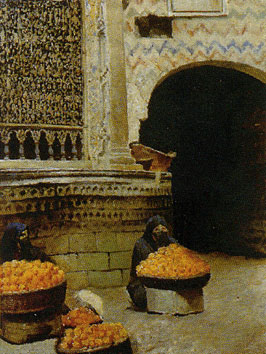
signed , inscribed and dated 'L. Deutsch Paris 1886'
painted in 1886
Oil on panel
20.5 x 16 in (52 x 40.7cm)
Like his sumptuous interior scenes, Ludwig Deutsch's renditions of the street life of Cairo were bravura exercises in the detailed rendition of surface textures, artfully composed from the artifacts and sketches he brought back to his studios. However, Deutsch was equally fascinated by the compositional possibilities afforded by everyday encounters between small crowds and a central figure-weather street vendors (fig.1), snake charmers or healers.

In the present work Ludwig Deutsch focuses on the two central figures of the orange seller and the buyer. In addition, the piles of oranges painted with a startling saturated, cadmium-based paint immediately succeed in locking the viewer's attention on the picture plane. This daring use of color in 1886 is a precursor to the brightly colored The Palace Guard of 1892.
In the Orange Seller, Cairo, the costume of the female figure offering an orange to the standing man is the same dress and head coverings as that of the sitter in The Sahleb Vendor, Cairo, 1886 (fig2.), but here she is seen with her back to the viewer on the right. This repetition of objects and textiles in Deutsch's work is typical and frequent.

Often these pieces belonged to the artist and he was able to reuse them in numerous compositions. In addition, Deutsch also collected photographs of exotic objects in his archives and he would draw upon these frequently.
A preparatory oil sketch for the present painting titles Marchande d'oranges(fig.3)

reveals that compositionally Deutsch experimented with the placement of the baskets of oranges as well as the positioning of the central figure of the orange seller prior to settling on this final composition. Some changes have been made: in Marchande d'oranges both ladies are wearing the traditional veil, whereas in the The Orange Seller the female sitter has removed her veil. This adjustment to the final composition enhances the interaction between the man and the female merchant thereby heightening the human drama.
Source: Christie's Orientalist Art 2005 P.16


 World Portraits
World Portraits The Orientalists
The Orientalists Pets
Pets Sur La Table
Sur La Table Garden Delights
Garden Delights Visit My Store
Visit My Store Painting Portfolio
Painting Portfolio



No comments:
Post a Comment